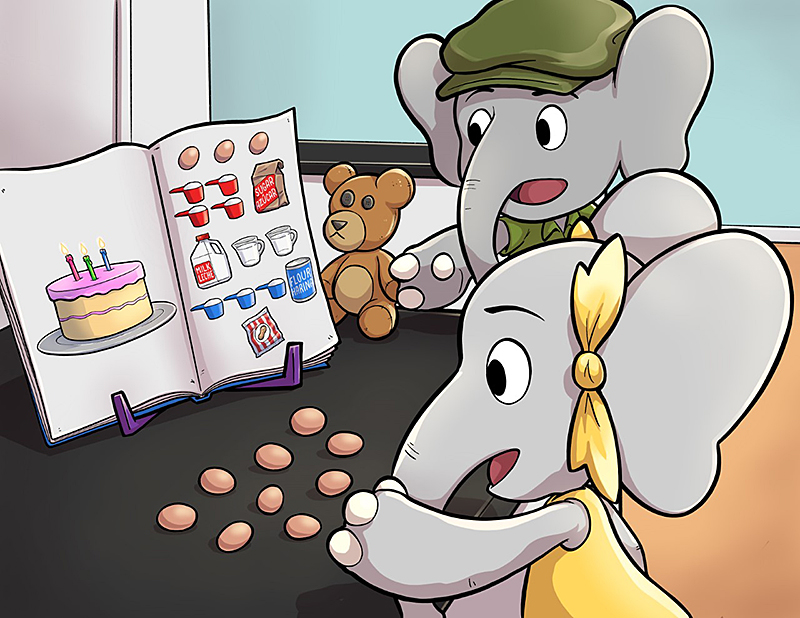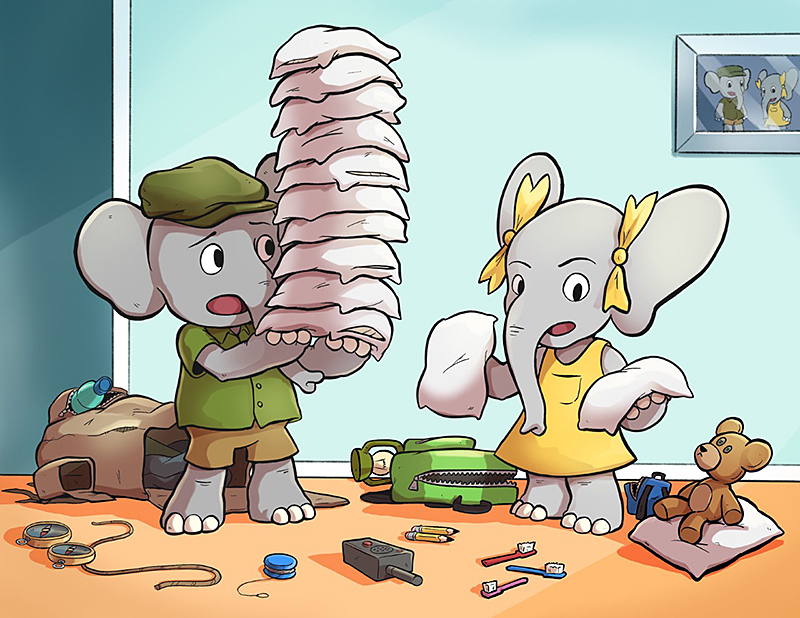May 5, 2021
Want to improve your child’s math skills? Read them a book.

Elephants-and-eggs: The Little Elephants try to bake a cake in David Purpura’s early math picture book “Just Enough Eggs.” (Image provided)
WEST LAFAYETTE, Ind. — Parents can improve their preschool child’s math skills by reading specially designed math picture books to them, according to a new study at Purdue University.
Through a grant from the Heising-Simons Foundation, David Purpura, associate professor in the Department of Human Development and Family Studies, and his colleagues collaborated with a professional children’s book author and illustrator to produce “The Little Elephants” series starring Benjamin, Lucy and their best friend, Bear — and then conduct a study. The results of the study were published April 15 in the Journal of Educational Psychology.
Early math language — words and concepts such as more, most, same, similar, different, few, less — are important for developing a foundation in math, so Purpura and his colleagues decided to design picture books that had these words embedded in the storyline to help parents engage their children in math at home.
“By embedding math into the books,” Purpura said, “we are able to support parents in teaching their children math in an activity that they already typically do.”
Seventy-four children and their caregivers participated in this study. Half of them read three books with math language in them four times each over four weeks. The other half read similar books that did not have the math language in them. They found that the intervention had strong effects on children’s math and math language development that sustained even two months after the intervention.
“We were really excited about these findings because parents and children really enjoyed the books, and the books helped to improve children’s math skills,” Purpura said. “In our prior work, we found that there weren’t a lot of books that had math language in them and great storylines.”
Research suggests that asking questions to engage children in books is one of the best ways to build their language skills. Purpura’s books contain questions on each page for parents to ask their children. The questions facilitate conversation between child and parent and ignite verbal mathematical reasoning within the child. Questions increase in complexity across the book and across the readings. An example: In “Just Enough Eggs,” the Little Elephants attempt to bake a cake.
 Elephants-and-pillows: The Little Elephants plan a sleepover in David Purpura’s early math picture book “Too Many Pillows.” (Image provided)
Download image
Elephants-and-pillows: The Little Elephants plan a sleepover in David Purpura’s early math picture book “Too Many Pillows.” (Image provided)
Download image
When Lucy accidentally breaks some of the eggs, parents are prompted to ask, “Why aren’t there enough eggs?” and “Now they have a different number of eggs as the recipe. How can they have the same amount?”
“We wanted to support parent-child engagement during reading by building engaging questions onto each page of the book,” Purpura said. “I have four kids of my own, and when I read to them, it can be challenging to come up with questions on the spot — and this is what I do research on! That’s why we wanted to include them in the books for families.”
Sara Schmitt, associate professor in the Department of Human Development and Family Studies, is the co-principal investigator on the project. She said picture books and the interaction between parent and child can lay the foundation for academic success later in school. Schmitt has read the books to her 3-year-old and was excited about the math interest that was generated.
“Asking the embedded questions during the readings provided a fun and engaging opportunity to talk about math,” Schmitt said. “Children do seem to have a natural curiosity for early math concepts; however, they need to be exposed to informal and formal math experiences and instruction in order to fully develop their mathematical competencies. The books are one way to do that.”
More to come
Purpura and his collaborators are continuing to develop other “Little Elephants” books through grants from the National Science Foundation and Institute for Education Sciences. They currently have six more titles in various stages of development.
Purpura also developed a series of educational books called “The Pattern Pals,” which is focused on early patterning skills with students from Purdue’s Honors College. These books follow Zoe the Parrot and Clara the Chameleon as they recognize patterns at the library, a birthday party and during a sleepover. Students from the Honors College and College of Education are working with Purpura to produce digital versions of “The Pattern Pals” series in the form of e-books and a 3D animated short video. The group applied for a grant in February to make the three “Little Elephants” titles into e-books as well.
“The Little Elephants” and “The Pattern Pals” books are available on Amazon. Funds from the sale of the books go into an account at Purdue for use in developing new books and purchasing books in bulk to distribute. Purpura does not personally receive royalties from the sale of the books.
About Purdue University
Purdue University is a top public research institution developing practical solutions to today’s toughest challenges. Ranked the No. 5 Most Innovative University in the United States by U.S. News & World Report, Purdue delivers world-changing research and out-of-this-world discovery. Committed to hands-on and online, real-world learning, Purdue offers a transformative education to all. Committed to affordability and accessibility, Purdue has frozen tuition and most fees at 2012-13 levels, enabling more students than ever to graduate debt-free. See how Purdue never stops in the persistent pursuit of the next giant leap at https://purdue.edu/.
Writer: Tim Brouk, tbrouk@purdue.edu
Media contact: Matthew Oates, 765-586-7496, oatesw@purdue.edu, @mo_oates
Source: David Purpura, purpura@purdue.edu, @davidjpurpura
Journalists visiting campus: Journalists should follow Protect Purdue protocols and the following guidelines:
- Campus is open, but the number of people in spaces may be limited. We will be as accommodating as possible, but you may be asked to step out or report from another location.
- To enable access, particularly to campus buildings, we recommend you contact the Purdue News Service media contact listed on the release to let them know the nature of the visit and where you will be visiting. A News Service representative can facilitate safe access and may escort you on campus.
- Correctly wear face masks inside any campus building, and correctly wear face masks outdoors when social distancing of at least six feet is not possible.
ABSTRACT
Engaging caregivers and children in picture books: A family-implemented mathematical language intervention
David Purpura, Sara Schmitt
DOI link
The goal of this study was to evaluate immediate and delayed effects of a caregiver-implemented picture book intervention to support children’s mathematical language and numeracy skills. Eighty-four 3- to 5-year-olds (Mage = 4.14) were randomly assigned to intervention (n = 40) or active control (n = 44) conditions. Participants in the intervention condition received three researcher-designed picture books with embedded mathematical language content. The active control group received similar books without mathematical language content. All families were asked to read each book a total of four times over 4 weeks (a total of 12 reading sessions). Children were pretested, post tested, and delayed (8 weeks) post tested on mathematical language and numeracy. The intervention resulted in significant positive effects on mathematical language and numeracy at the posttest. At delayed posttest, the mathematical language effects were not statistically significant, but the numeracy effects persisted. However, when only examining the quantitative language items that aligned with the intervention, the effects of the intervention were significant at both immediate and delayed posttests. Findings suggest picture book interventions can have positive impacts on children’s early skills. (PsycInfo Database Record (c) 2021 APA, all rights reserved)
Note to journalists: Images of David Purpura and artwork from his books are available on a Google Drive. Journalists visiting campus should follow visitor health guidelines.

